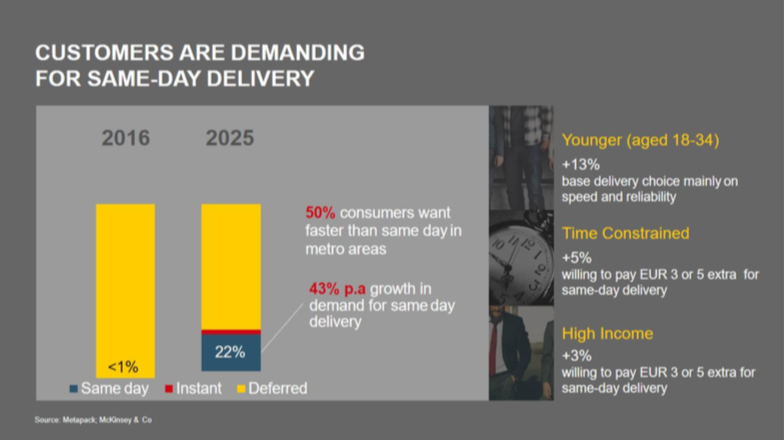
Impact of Growing E-Commerce on Logistics Service Providers
By David Rogers
Impact of Growing E-Commerce on Logistics Service Providers
With more people around the globe resorting to online purchases for everything from pharmaceuticals and groceries to fashion and footwear, the e-commerce industry has been growing by leaps and bounds (Refer largest markets and trade lanes). While countries like China, the United States, and Japan are the top three players in the current e-commerce sphere (accounting for 21%, 16.8% and 10.4% of the world’s e-commerce retail sales as of 2017 respectively, Source: Euromonitor International 2017, Modern Spice Route Paypal 2013 ), it is countries such as India and Canada that are slated to be the key players in the foreseeable future. Whilst the world is still coming to terms with the e-commerce boom, the impact that it has had on other associating industries such as logistics has also been tremendous. So much so, the global logistics market in the e-commerce realm is expected to reach $726 billion by 2020 (source: Capgemini , BNP Paribas )

Impact on LSPs
Before the dawn of e-commerce, traditional logistics was as simple as moving goods from manufacturing hubs to consumption centers through the means of a linear routing system. Logistics services for e-commerce, however, must adopt a combination of one-to-many, one-to-one and many-to-one routing mechanisms based on the availability of merchandise and the delivery destinations. As e-commerce markets in metropolitan cities and suburban areas continue to grow, the constant need for logistics markets to scale up their operations remains paramount.
Effects of Free Shipping, Easy Returns, Multi-Delivery Options
With the odds of a person returning something that they ordered online getting higher each year, e-commerce giants and their associated logistics providers have had a lot to think about. These odds aren’t alarming because the entire entity of e-commerce retail purchasing involves an inherent risk, in that customers make purchases out of a leap of faith as opposed to witnessing the quality of a product first-hand at a store.
More online merchants are beginning to entice customers through free shipping, easy returns, and other such policies, in the hope of winning their trust, by following what is called the omnichannel retail approach. The omnichannel approach, in a nutshell, is a retail sales method that seeks to provide the customers with a seamless shopping experience irrespective of whether the customer is shopping online from a mobile, tablet device, desktop, in a brick and mortar store or by telephone.
Some of the ways in which logistics services can meet these drastically increasing requirements are listed below:
Increase the Number of Distribution Centers
With the omnichannel approach to e-commerce retail gaining ground, there will be a major overhaul for distribution centers near growing urban markets. Logistics service providers having a well-planned network of strategically placed supply chain real estate, are the only ones who will be equipped to handle scalability issues that the drastically growing requirements of the e-commerce market is sure to impose on them.
Reducing Cost of Operations
To keep up with the rapidly increasing number of omnichannel retailers and consumers, it is imperative for LSPs to develop new freight pricing models. With consumers having become fond of free shipping and premium membership schemes that guarantee “within a day” or same day deliveries (Refer Customers are Demanding for Same Day Delivery graphic below), the costs for logistics services have gone up. As the costs incurred because of these schemes are many and oftentimes complex to calculate, it is of high importance that LSPs develop freight pricing models that are sophisticated enough to aptly determine the variables, in turn enabling them to price their services fairly.

Improving Reverse Logistics
Reverse logistics comprises any activity associated with a product after its sale, with the aim being to optimize and improve market activity, thus saving more resources and money. Efficient reverse logistics can be employed to tackle the perennial hassle of returns that LSPs face. This entails efficient separation and processing procedures for returned products, that help reduce costs and keep losses to a minimum. As more e-commerce retailers look to reverse logistics to extract as much value as they can from returns, it is up to LSPs to adopt efficient enough policies that help them cater to their needs. Ecommerce players put quite a lot of pressure on LPSs to cutdown the cost for handling returns as returns are not paid for by customers. Although trends such as omnichannel retail as well as stringent regulations are making reverse logistics a nightmare for a lot of LSPs worldwide, more efficient use of data and better end-to-end visibility can help resolve these issues.
Better End-to-end Visibility
Having better end-to-end visibility for LSPs means that they must have clearer insights into various components of the network. A robust information system coupled with more efficient route plans and fleet management result in a seamless approach to providing quality logistics services. With the complexities of omnichannel retailing being added, it is crucial for LSPs to constantly rethink their strategies and methods of approach. LSPs will have to be able to efficiently optimize their networks to satisfy the growing needs of their retail customers.
As the e-commerce boom is still in its initial stages, the only thing that LSPs can do to in terms of being prepared, is to constantly keep up with and adapt to the changing landscape of global e-commerce retail. The future is exciting - definitely for Logistics Service Providers!
About the Author
 David is part of the BPI membership community and is exceptionally experienced in supply chain management, logistics, and strategy. He is currently running his own boutique consulting business called Insync Supply Chain Management Pty Ltd which provides an extensive range of supply chain consulting services across Australia and Asia. Insync Supply Chain Management Pty Ltd has significant expertise in the development and execution of supply chain strategies, transforming the integration, alignment and functional synchronization across all supply chain stakeholders. Prior to starting his own business, David worked in the corporate environment in various senior supply chain management positions with blue chip companies. David has also lectured on Supply Chain Management at RMIT University and Victorian University.
David is part of the BPI membership community and is exceptionally experienced in supply chain management, logistics, and strategy. He is currently running his own boutique consulting business called Insync Supply Chain Management Pty Ltd which provides an extensive range of supply chain consulting services across Australia and Asia. Insync Supply Chain Management Pty Ltd has significant expertise in the development and execution of supply chain strategies, transforming the integration, alignment and functional synchronization across all supply chain stakeholders. Prior to starting his own business, David worked in the corporate environment in various senior supply chain management positions with blue chip companies. David has also lectured on Supply Chain Management at RMIT University and Victorian University.
David is the Chairman Asian Pacific Logistics Federation (APLF), Past Chairman – Director of the Supply Chain Logistics Australia Association (SCLAA), Australian Roundtable President of the Council of Supply Chain Management Professionals (CSCMP), National Councilor for GS1 Board in Australia.
For more information regarding his blogs, please navigate to this page: http://www.iscm.com.au/2018/02/15/six-disruptive-forces-shaping-the-future-of-logistics-force-six/


